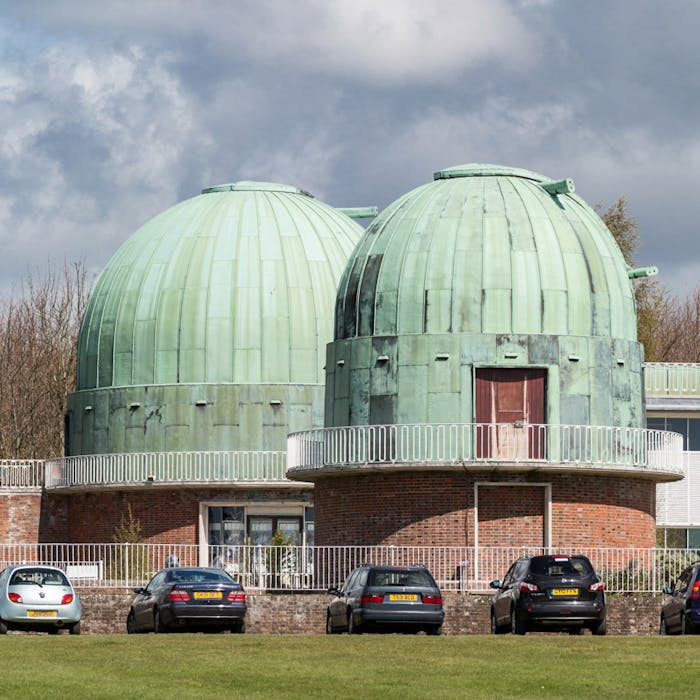
Herstmonceux Observatory - a short but vibrant heyday
Now known as the Observatory Science Centre, the array of telescopes in the countryside near Herstmonceux, East Sussex, was for several decades the home of the Royal Greenwich Observatory - when it moved out of central London to escape light pollution.
From the nineteenth century, astronomers at London's famous Greenwich Observatory found that the city's smoky air and bright lights meant that astronomers could no longer study faint objects in the night sky. By the early twentieth century, London had expanded so much that Greenwich was enveloped. In 1933, Spencer Jones was appointed as the Astronomer Royal, and he began plans to relocate the observatory to a better site. After plans were delayed by World War II, the transfer to East Sussex began in 1947, and by 1958 the Royal Greenwich Observatory was fully up and running at Herstmonceux.
At its peak, over 200 people worked at The Observatory in Herstmonceux and lived in the local community. It was the unique mix of skills and personalities that made the place what it was and enabled it to enjoy a world-wide reputation for excellence.
The site was constructed to house three reflecting and three refracting telescopes in six green domes. It is known as the ‘Equatorial Group' after the way the telescopes are mounted. The architect was Brian O' Rorke and the work was completed in 1958.
With its unique arrangement of domes around a central bastion the Equatorial Group was one of the most important government commissioned building projects of its period. The domes were clad in copper sheet and coated with a chemical that has helped them to weather to today's distinctive green - one of the features that was intended to make the buildings blend into the Sussex countryside. Much effort was made to use attractive building materials in keeping with local traditions. The result is definitely mid-century in style, but indefinably odd.
Despite the care and expense of the project, astronomers found the layout inconvenient and even hazardous - with various levels and walkways across the lily pond to be taken in darkness, with few of the current railings in place.
The existing telescopes were augmented in 1967 by the giant 98-inch Isaac Newton Telescope (INT) once housed in the silver dome to the south of the main complex.
During its days at Herstmonceux, the Royal Greenwich Observatory (RGO) built up an enviable reputation for world-class astronomical research. Each year the nearby Herstmonceux Castle was the venue for a major conference attracting top astronomers from all over the world.
RGO was also responsible for more routine work, involving the careful mapping of star positions, monitoring of solar activity and provision of a national time service. It was from the observatory's atomic clocks at Herstmonceux that the familiar 'six-pips' were sent by land-line to the BBC for broadcast. Today, the BBC generates the 'pips' for themselves.
Life at the RGO during the early years at Herstmonceux is remembered as idyllic. The staff were working in extremely pleasant surroundings, many pursuing research into a subject dear to their hearts, and everyone feeling that they belonged to something worthwhile. The setting of the castle and its grounds were far removed from an office in a city centre. These were the days of jobs for life. Conditions of employment were linked to the civil service and staff enjoyed good holiday allowances, a guaranteed job and a pension at the end of it. The pay may not have rivalled that available in outside industry, but there seems to have been a strong community spirit, and there were many social activities.
Unfortunately, even Herstmonceux is not a good astronomical site in world terms and the unreliable UK weather meant that the Isaac Newton Telescope (INT) could not be utilised as much as it should have been. With the advent of cheap air travel in the sixties it became feasible for astronomers to travel to other observatories in order to use telescopes in the best possible locations. Eventually, the decision was taken to establish a major overseas observatory in the northern hemisphere and to move the INT there, where it could be put to better use.
In 1979 the telescope was dismantled, removed from its dome and completely refurbished before being installed on top of an extinct volcano on the Canary Island of La Palma in 1984. Here it formed part of the International 'Roque de los Muchachos Observatory' run as an overseas facility by the Royal Greenwich Observatory.
With its main telescopes located abroad, resources for maintaining the instruments at Herstmonceux diminished and they were used less and less. Eventually, the decision was taken to move the Observatory again, this time to a new site at Cambridge, adjacent to the University's Institute of Astronomy. The Observatory moved to Cambridge in 1990 leaving behind the Equatorial Group of Telescopes.
The former observatory has now become a 'hands-on' science centre, and also a local centre for stargazing events. Though no longer at the heart of cutting edge science and astronomy, the centre receives over 60,000 visitors a year.
The Royal Observatory closed in Cambridge only eight years after the move in 1998.
Further reading
Links to external websites are not maintained by Bite Sized Britain. They are provided to give users access to additional information. Bite Sized Britain is not responsible for the content of these external websites.
